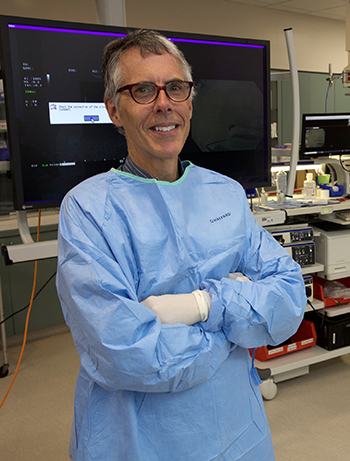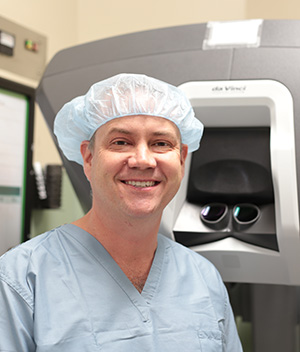Tiny technology helps find and remove small, peripheral lung cancers
Cancer
Dr. M. Douglas Mullins and Dr. Marc Bailey use a fiducial to remove small lung cancers that would otherwise grow or require a lobectomy
For selective lung cancer patients, St. Joseph’s/Candler has a new tool to help guide treatment without having to remove a large portion of the lung.
Using a marker called a fiducial, Dr. M. Douglas Mullins places this marker through Monarch Robotic technology. Then Dr. Marc Bailey removes the abnormality at the site of the marker through minimally-invasive surgery with the da Vinci robot®.

“We are resecting tiny little cancers,” Dr. Mullins says. “In some of these cases, the patient goes home the same day. It is fantastic. We are really leading the way.”
In fact, currently St. Joseph’s/Candler is one of a very few centers in the nation using this type of fiducial to remove small lung cancers.
The fiducial is a nickel titanium coil with a polyester coating that emits to a green dye. It is so tiny it can’t be seen or even felt without the use of imaging.
The fiducial is placed at the site of the abnormality using the Monarch robot that is located in the Bronchoscopy Suite at Candler Hospital.
Related Article: New technology can help diagnose lung cancers earlier, more accurately
Using a controller like you would find on a PlayStation, Dr. Mullins is able to navigate a flexible robotic bronchoscope to the lung using computer guidance and virtual imaging. He then pushes tiny wires through the scope to push a “cocktail straw sized” tube to the spot on the lung where the nodule is located. The fiducial is pushed out of the “cocktail straw” and coils up and lights up.
The fiducial will be visible with imaging for up to seven days, but in most cases, patients have surgery with Dr. Bailey on the da Vinci robot within 48 to 72 hours.
“If the tumor is too small, you can’t find it without taking a big portion of the lung, but if I mark the nodule, the florescent green dye lights up with a setting on da Vinci,” Dr. Mullins explains. “Dr. Bailey can go in and remove the green thing because I’ve marked where the cancer is. Otherwise, it’s like finding a needle in a haystack.”

The fiducial can’t be placed for all lung cancer patients. The tumor (often found on an incidental imaging test) has to be very small, and it has to be around the peripheral of the lung.
“The idea is that you see the dye. If the nodule is located deep in the lung and it’s small, you won’t be able to see it,” Dr. Mullins explains. “So it has to be near the surface so we can see the fiducial.”
While it can’t be used in all cases of lung cancer, the fiducial has been a game changer for qualified patients. Before, if a tiny tumor was discovered you had three options: wait for it to grow, ignore it or get that whole part of your lung removed because otherwise you couldn’t find it, Dr. Mullins says.
Now, a lobectomy (removing a lobe of the lung) may be avoided and the cancer doesn’t grow.
“We’ve had fantastic outcomes with this fiducial,” Dr. Mullins says.
Dr. Mullins sees patients at the Advanced Thoracic Oncology Center at the LCRP in Savannah and each Wednesday in Hardeeville, SC.